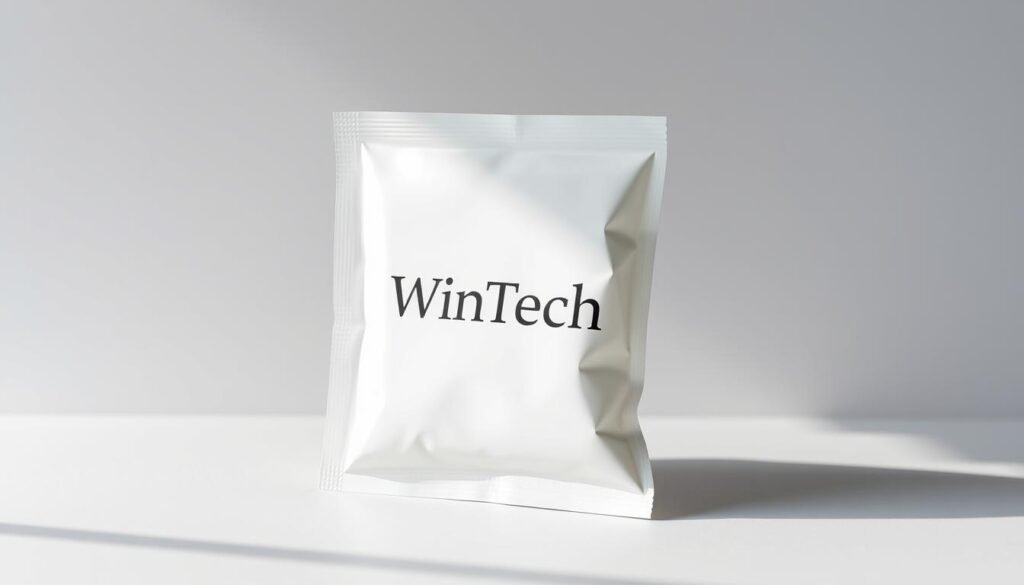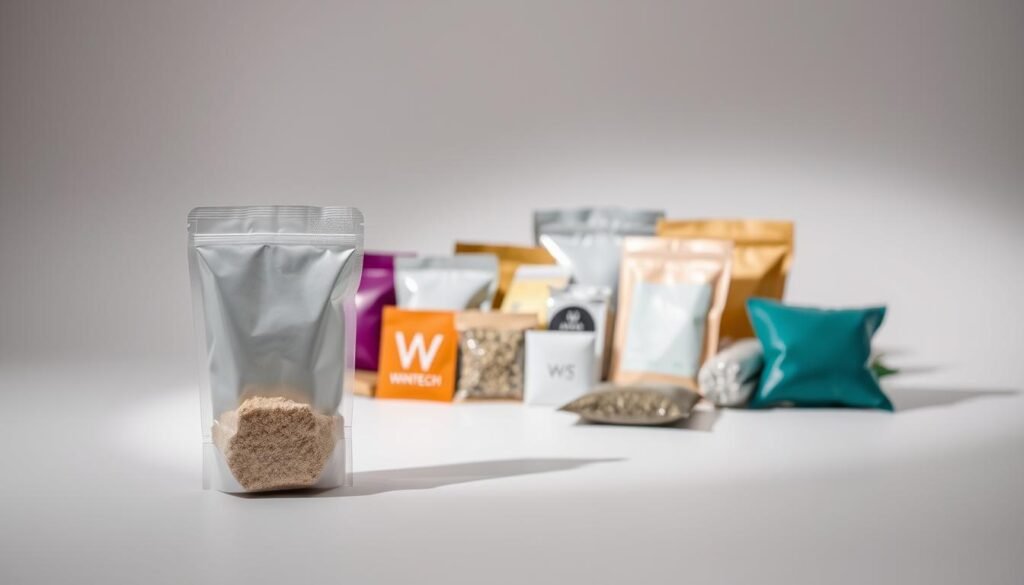Are you aware of the packaging solutions that can significantly enhance your business’s storage and logistical efficiency? Flexible packaging is revolutionizing the way companies operate, and sachets are at the forefront of this change.
So, what are sachets? Essentially, they are small, flexible packets used for packaging various products, including food, cosmetics, and pharmaceuticals. Their lightweight and compact design makes them an attractive option for businesses looking to optimize their supply chain.
Key Takeaways
- Understanding What Are Sachets and how it improves storage efficiency by reducing packaging material space.
- They offer logistical benefits due to their lightweight and compact nature.
- Sachets can be designed with features like resealable zippers for consumer convenience.
- The use of sachets can lead to cost savings and enhanced product protection.
- Businesses in the U.S. are increasingly adopting sachets for their packaging needs.
Understanding What Are Sachets and Their Role in Packaging
In the realm of packaging, sachets have emerged as a versatile solution, catering to various industries including food, cosmetics, and pharmaceuticals. Sachets are small, sealed packets made of flexible material, used for containing a variety of products.

Definition and Overview of Sachets
Sachets are designed to provide a convenient and efficient way to package products. They are made from a range of materials, including paper, plastic, and biodegradable substances, each offering different advantages in terms of sustainability, durability, and product compatibility.
Common Uses of Sachets
Sachets are widely used in various industries due to their versatility. Common applications include packaging food items like sauces and seasonings, cosmetics such as creams and lotions, and pharmaceutical products like powders and liquids.
- Food industry: sauces, seasonings, coffee, and tea
- Cosmetics: creams, lotions, shampoos, and conditioners
- Pharmaceuticals: powders, liquids, and medicinal samples
Benefits of Using Sachets
The use of sachets offers several benefits, including cost-effectiveness, product freshness preservation, and convenience for consumers. Sachets require less material than traditional packaging methods, making them an economical choice.
Moreover, sachets can be designed with features such as windows for product visibility, tear notches for easy opening, and resealable zippers for consumer convenience.
Types of Sachets Available
There are several types of sachets available, catering to different product needs and consumer preferences. These include sachets made from various materials such as aluminum, paper, and plastic, each with its own set of benefits and drawbacks.
| Material | Benefits | Drawbacks |
|---|---|---|
| Aluminum | Excellent barrier properties | Less environmentally friendly |
| Paper | Biodegradable and sustainable | May not be suitable for all products |
| Plastic | Flexible and durable | Environmental concerns |
The Role of What Are Sachets in Supply Chain Management
What are sachets have emerged as a crucial element in streamlining supply chain operations, offering numerous benefits to U.S. businesses. By improving packaging efficiency, reducing costs, and enhancing inventory management, sachets play a vital role in modern supply chain management.
Improving Efficiency with What Are Sachets
The use of sachets in supply chain management significantly improves operational efficiency. Sachets reduce packaging time and costs by providing pre-measured quantities of products, thereby minimizing waste and optimizing packaging processes. This efficiency gain allows businesses to allocate resources more effectively, enhancing overall productivity.
Moreover, sachets help in reducing product damage during transportation. Their compact, secure packaging ensures that products are protected from external factors, thereby reducing the likelihood of damage and loss. This aspect is particularly crucial in maintaining high product quality and customer satisfaction.
Integration of What Are Sachets in Warehousing
The integration of sachets in warehousing involves designing storage systems that can efficiently handle and dispense these small packets. Automated packaging lines and inventory management systems that track sachets from production to delivery are essential components of this integration. By leveraging these technologies, businesses can achieve a more streamlined and efficient warehousing process.
- Automated packaging lines for sachets enhance production speed and accuracy.
- Inventory management systems provide real-time tracking of sachet inventory.
- Efficient storage solutions maximize warehouse space utilization.
The Impact of What Are Sachets on Inventory Control
The impact of sachets on inventory control is significant. By allowing for more precise control over product quantities, sachets enable businesses to adopt a just-in-time inventory management approach. This means products are packaged and shipped in smaller, more frequent batches, reducing the risk of inventory obsolescence and minimizing storage needs.
Furthermore, the use of sachets facilitates better demand forecasting and responsiveness. With the ability to package and ship products in smaller quantities, businesses can respond more quickly to changes in demand, improving their overall agility and competitiveness in the market.
What Are Sachets: Environmental Considerations
Sachets are increasingly being examined for their environmental footprint and potential for sustainability. As the world grapples with the challenges of waste management and environmental conservation, the role of sachets in packaging is under scrutiny. You, as a business owner or consumer, play a crucial part in shaping the future of sachet usage.

Sustainability Practices in Sachet Production
The production of sachets involves various materials, including plastics, papers, and bioplastics. To enhance sustainability, manufacturers are exploring eco-friendly sachet materials that are biodegradable or compostable. For instance, some companies are using plant-based bioplastics that reduce dependence on fossil fuels and lower carbon emissions.
The use of recycled materials in sachet production is another significant step towards sustainability. By incorporating recycled content, manufacturers can reduce waste and conserve resources. You can contribute to this effort by choosing products packaged in sachets made from recycled or recyclable materials.
Reducing Waste through Efficient Sachet Design
Efficient design of sachets can significantly reduce packaging waste. By optimizing the size and material usage, sachets can minimize excess packaging while maintaining product protection. The sachet industry is adopting innovative designs that not only reduce material usage but also enhance the user experience.
One approach to reducing waste is the use of minimal packaging designs that eliminate unnecessary components. This not only reduces the environmental impact but also appeals to consumers who prefer streamlined packaging. You can make a difference by supporting brands that adopt such practices.
Consumer Trends Influencing Sachet Use
Consumer preferences are driving changes in the sachet industry, with a growing demand for sustainable and eco-friendly packaging solutions. You, as a consumer, are increasingly seeking products with minimal packaging, and this trend is influencing how sachets are designed and used.
The demand for transparency regarding the environmental impact of packaging is also on the rise. Consumers are looking for information on the recyclability and compostability of sachets. In response, companies are providing clearer labeling and information on the environmental credentials of their packaging.
Future Trends Regarding What Are Sachets in U.S. Markets
The demand for flexible packaging solutions like sachets is expected to continue growing in U.S. markets, driven by consumer preferences for convenience, sustainability, and product freshness. As the packaging industry evolves, innovations in sachet design will play a crucial role in their adoption.
Design Innovations and Market Predictions
New materials and technologies, such as edible sachets and sachets with integrated RFID tags, are being developed to enhance the benefits of sachet packaging. The sachet industry is predicted to experience significant growth across various sectors, driven by the cost-effectiveness, sustainability, and convenience offered by sachets.
Adapting Business Strategy
To leverage the sachet benefits, businesses should stay informed about the latest trends and innovations in packaging. Investing in research and development to create competitive sachet products and focusing on sustainability and consumer convenience in packaging design are essential strategies. By embracing sachets, businesses can improve their supply chain efficiency, reduce their environmental footprint, and enhance their brand reputation.
